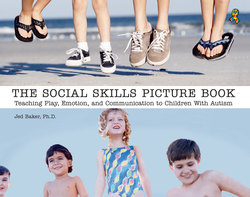Читать книгу The Social Skills Picture Book - Jed Baker PhD - Страница 13
На сайте Литреса книга снята с продажи.
Оглавлениеxii
By definition, autism refers to difficulties in all three of the core symptom areas (social interaction, communication,
repetitive behaviors). However, there are individuals who have difficulties in one or two areas, but not a third. As a result
of the variety of symptom profiles across these three areas, researchers and clinicians often refer to them as autism
spectrum disorders rather than just referring to autism. Autism spectrum disorders include autism (and high-functioning
autism), Asperger’s Syndrome, and Pervasive Developmental Disorder-not otherwise specified (i.e., PDD-NOS, a category
for individuals who meet some of the criteria for an autism spectrum disorder, but do not fit neatly into a specific disorder
like autism or Asperger’s Syndrome). Within the autism spectrum there are individuals with no language and severe
mental retardation, as well as people who are very articulate with gifted IQs, despite problems in social interaction and
repetitive behaviors. For example, individuals with Asperger’s Syndrome have average to above average intellectual
development, few or no problems with the structural use of language, but have problems in social interaction and
repetitive behaviors.
Given the variety of symptoms and intellectual functioning among individuals with autism spectrum disorders, a
number of researchers have theorized about the core underlying problem within the disorders. Three, perhaps related,
theories have received the most attention:
•
Frith (1989) suggests that autistic individuals lack the ability to simultaneously integrate multiple language, social,
and emotional messages typically present in social situations. Something about their neurological functioning
makes it difficult to assimilate and organize all the pertinent information. Since most social situations have multiple
levels of sensory input, autistic individuals do not always fully grasp what is happening or how to respond. Instead,
they may attend to and process only a fragment of the social experience, resulting in repetitive and atypical social
behavior.
•
Baron-Cohen (1995) suggests that the core problem is the inability to understand the thoughts and feelings of
others, a process termed “theory of mind.” Thus, autistic individuals have difficulty taking other people’s
perspectives.
•
Hobson (1996) suggests that autism involves the inability to perceive and understand emotional expressions. This
would then lead to difficulties in perspective taking and subsequent problems in social interaction.
These three theories can be considered complementary. Both Baron-Cohen and Hobson’s theories suggest that
autistic individuals cannot easily empathize or understand another person’s view of the world. Frith’s theory helps explain
why. The inability to simultaneously integrate information about what is happening in a social situation makes it difficult
to imagine what others might be thinking and feeling. To take another’s perspective, one has to synthesize information
about the other person (e.g., the person’s recent past experiences and preferences), along with what is happening to the
person.
Most social skills rely on the ability to mentally adopt another person’s perspective. For example, knowing why to
say hello when you greet someone is based on understanding how others might think or feel if you ignore them rather
than greet them. Knowing when to stop talking, take turns, respond to others’ initiations, compromise, help others, or
